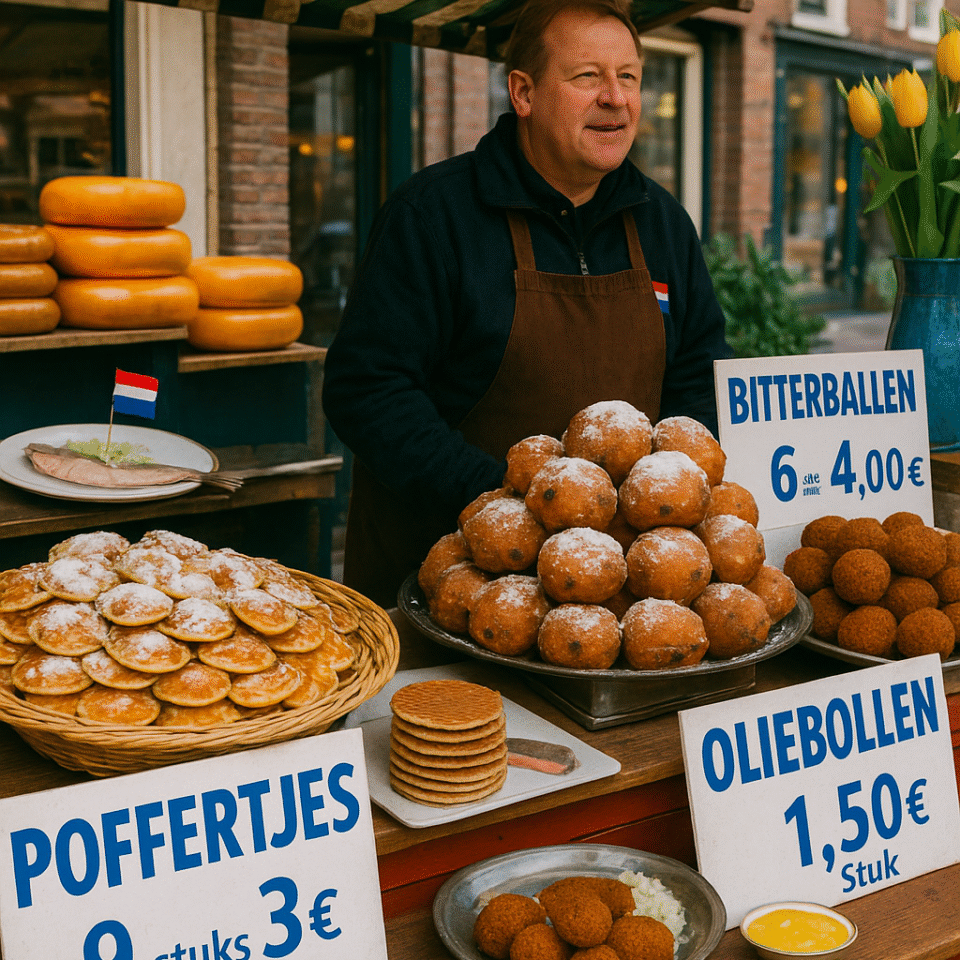When I first moved from the United States to the Netherlands, I expected a culinary landscape dominated by cheese and potatoes. While these staples do feature prominently, Dutch cuisine offers far more complexity and flavor than most Americans anticipate. The Netherlands has a rich food culture shaped by its maritime history, agricultural traditions, and colonial past, resulting in dishes that are hearty, comforting, and surprisingly diverse.
Whether you’re planning a visit, considering a move, or simply curious about what Dutch people eat, this guide will introduce you to ten essential Dutch foods that every American should experience. I’ll share where to find the most authentic versions and my personal tips for enjoying them like a local.
1. Stroopwafels: The Sweet Dutch Icon
Where to Find: Local markets, supermarkets, and specialty bakeries
Stroopwafels are perhaps the most internationally recognized Dutch sweet treat, and for good reason. These thin waffle cookies filled with caramel syrup (stroop) originated in Gouda during the late 18th century and have since become a national favorite.
What makes them special is the perfect balance between the slightly crisp, cinnamon-infused waffle exterior and the gooey caramel interior. Americans often find these reminiscent of a thin, flexible cookie rather than the thick Belgian waffles we’re used to.
Authenticity Tip: For the quintessential Dutch experience, place your stroopwafel atop a hot cup of coffee or tea for a minute or two. The steam will warm the caramel, creating a melty, delicious treat.
Where to Try the Best: While packaged versions from Albert Heijn (the Netherlands’ largest supermarket chain) are quite good, nothing beats freshly made stroopwafels from local markets. The Albert Cuyp Market in Amsterdam offers some of the best, made right before your eyes.
2. Bitterballen: The Ultimate Dutch Bar Snack
Where to Find: Brown cafés (traditional Dutch pubs), restaurants, and snack bars
If there’s one savory Dutch snack that captures Americans’ hearts, it’s bitterballen. These crispy, deep-fried balls contain a creamy ragout of beef or veal, typically seasoned with nutmeg, parsley, and other spices. They’re traditionally served with mustard for dipping.
What often surprises Americans is the contrast between the crunchy breadcrumb exterior and the smooth, almost molten interior. They’re the perfect accompaniment to Dutch beer and a must-try during any visit to a local pub.
Authenticity Tip: Dip them in mustard, but be careful when taking your first bite—the interior is often scorching hot!
Where to Try the Best: Café Hoppe in Amsterdam, established in 1670, serves excellent bitterballen in an authentic brown café atmosphere that will transport you back in time.
3. Haring (Dutch Herring): A Maritime Tradition
Where to Find: Street stalls called “haringhandels,” fish markets, and food festivals
Raw herring might sound intimidating to many Americans, but this Dutch delicacy is a cornerstone of the country’s culinary identity. The herring is lightly brined (not completely raw) and served with chopped onions and pickles.
What makes Dutch herring unique is the preparation method—the fish is gutted while preserving the pancreas, which releases enzymes that enhance flavor during the short curing process.
Authenticity Tip: Try eating herring the traditional Dutch way: hold it by the tail, tilt your head back, and lower the fish into your mouth. Alternatively, you can enjoy it in smaller pieces on bread (broodje haring) for a less intimidating introduction.
Where to Try the Best: Visit Frens Haringhandel in Amsterdam or head to the Scheveningen harbor near The Hague, particularly during the “Hollandse Nieuwe” season (new herring) which typically begins in June.
4. Poffertjes: Fluffy Miniature Pancakes
Where to Find: Pancake houses, festivals, markets, and specialty restaurants
Poffertjes are small, fluffy pancakes that capture the hearts of Americans with their pillowy texture and sweet simplicity. Made from buckwheat flour, these bite-sized treats are traditionally served with a generous dusting of powdered sugar and a small pat of butter.
Unlike American pancakes, poffertjes are made using a special cast iron pan with shallow indentations, giving them their characteristic puffy shape and light interior.
Authenticity Tip: While they’re delicious year-round, poffertjes are especially enjoyable during winter months at Christmas markets, where you can watch them being made and enjoy them fresh and warm.
Where to Try the Best: Poffertjes & Pannenkoekenhuis De Carrousel in Amsterdam offers traditional poffertjes in a charming setting. The historic Pancake House Upstairs also serves excellent versions.
5. Kroketten: The Convenient Dutch Comfort Food
Where to Find: Snack bars, fast food outlets, and even vending machines
Kroketten are essentially larger cousins of bitterballen, featuring the same creamy ragout filling but in an elongated form. They’re often enjoyed as a quick lunch option, served on white bread as a “broodje kroket” (kroket sandwich).
What fascinates many Americans is the FEBO phenomenon—automated walls of hot snacks, including kroketten, available for purchase by inserting coins and opening a little door. It’s fast food with a uniquely Dutch twist!
Authenticity Tip: Try different varieties beyond the standard beef—cheese, satay, and veal versions are all delicious.
Where to Try the Best: FEBO is an iconic Dutch experience, but for gourmet versions, try Van Dobben in Amsterdam, which has been making kroketten since 1945.
6. Erwtensoep (Split Pea Soup): Winter Comfort in a Bowl
Where to Find: Restaurants, cafés, and markets (especially during winter)
Also known as “snert,” erwtensoep is a hearty split pea soup that’s so thick a spoon can nearly stand upright in it. Packed with split peas, chunks of pork, sausage, and vegetables like carrots, onions, and celery, it’s Dutch comfort food at its finest.
Americans are often surprised by just how substantial this soup is—it’s more of a meal than a starter and perfect for the Netherlands’ cold, rainy winters.
Authenticity Tip: Erwtensoep is traditionally served with rye bread (roggebrood) and bacon (spek). It actually tastes better the day after it’s made, when the flavors have had time to develop.
Where to Try the Best: Restaurant Greetje in Amsterdam specializes in traditional Dutch cuisine and serves an excellent version during colder months.
7. Oliebollen: New Year’s Eve Tradition
Where to Find: Street vendors and bakeries (primarily from November through January 1st)
Oliebollen (literally “oil balls”) are deep-fried dough balls similar to donuts, typically dusted with powdered sugar. They’re a seasonal treat, mainly enjoyed during the winter holiday season and especially on New Year’s Eve.
What Americans might find interesting is that these treats are thought to be the precursor to the American donut, brought to New Amsterdam (now New York) by Dutch settlers.
Authenticity Tip: Look for varieties with raisins or currants mixed into the dough for added flavor and texture.
Where to Try the Best: Follow the locals to stands with the longest lines—they know which vendors make the freshest, lightest oliebollen. The annual Oliebollen Test by the newspaper AD ranks the best stands nationwide.
8. Speculaas: Spiced Cookies with History
Where to Find: Supermarkets, bakeries, and cafés (available year-round but especially popular during Sinterklaas season)
Speculaas are spiced shortcrust cookies traditionally associated with the feast of St. Nicholas (Sinterklaas) in early December. They’re flavored with a special spice mixture that typically includes cinnamon, nutmeg, cloves, ginger, cardamom, and white pepper.
Americans might recognize a simplified version marketed as “Biscoff” cookies, but authentic Dutch speculaas has a deeper, more complex spice profile and is often pressed into traditional wooden molds depicting Dutch scenes.
Authenticity Tip: For a truly indulgent experience, try “gevulde speculaas,” which contains an almond paste filling.
Where to Try the Best: Van Stapele Koekmakerij in Amsterdam for high-quality speculaas, or look for the premium versions by Verkade in supermarkets.
9. Stamppot: Dutch Comfort Food at Its Best
Where to Find: Home-style restaurants, winter markets, and family kitchens
Stamppot, a hearty combination of mashed potatoes mixed with vegetables like kale (boerenkool), sauerkraut (zuurkool), or carrots and onions (hutspot), represents the essence of traditional Dutch home cooking. It’s typically served with a smoked sausage (rookworst) and gravy.
Americans are often reminded of their own meat-and-potatoes traditions, but the Dutch preparation—particularly the integration of vegetables directly into the mash rather than serving them separately—offers a different approach to familiar ingredients.
Authenticity Tip: Create a small well in your stamppot for the gravy to pool, ensuring every bite gets some moisture and flavor.
Where to Try the Best: Moeders (meaning “Mothers”) in Amsterdam specializes in homestyle Dutch cooking and serves excellent versions of various stamppot varieties.
10. Dutch Cheese: Beyond Gouda and Edam
Where to Find: Cheese shops, markets, and specialty food stores
While Americans are generally familiar with Gouda and perhaps Edam, the Netherlands offers a rich variety of cheeses that go far beyond these famous exports. From young (jong) to extra-aged (overjarig) Gouda, from creamy Boerenkaas (farmhouse cheese) to cumin-infused Leidse kaas, Dutch cheese culture is diverse and sophisticated.
What surprises many Americans is how different authentic, aged Dutch cheese tastes compared to the milder versions exported to the US—expect more complex flavors, crystalline texture in aged varieties, and a wider range of tastes.
Authenticity Tip: Visit a cheese tasting room to sample different ages of the same cheese type to appreciate how aging transforms the flavor from mild and creamy to intensely caramelized and crunchy.
Where to Try the Best: Reypenaer Tasting Room in Amsterdam offers guided tastings, or visit the historic cheese markets in Alkmaar, Gouda, or Edam during their seasonal operations.
Conclusion: Embracing Dutch Food Culture
Exploring Dutch cuisine offers Americans a fascinating window into this small country’s rich cultural heritage and pragmatic approach to food. While some dishes might challenge American palates initially (raw herring, anyone?), most offer familiar flavors in new and interesting combinations.
As an American expat, I’ve found that sharing meals with Dutch friends and trying traditional foods has been one of the most effective ways to connect with local culture. Food tells stories about history, values, and daily life in ways that tourist attractions never could.
So whether you’re planning a short visit or considering a longer stay in the Netherlands, I encourage you to step outside your culinary comfort zone and sample these ten Dutch classics. Your taste buds—and your understanding of Dutch culture—will be richer for the experience.
Have you tried any of these Dutch foods? Which one sounds most appealing to you? Share your thoughts in the comments below!








